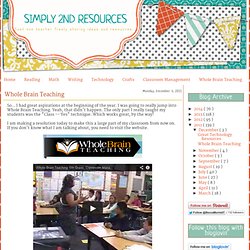

Simply 2nd Resources: Whole Brain Teaching. So...

I had great aspirations at the beginning of the year. I was going to really jump into Whole Brain Teaching. Yeah, that didn't happen. The only part I really taught my students was the "Class -- Yes" technique. Which works great, by the way! 10 Skills The Workforce of the Future Will Need "We are all interested in the future, for that is where we will spend the rest of our lives.

" -Plan 9 From Outer Space. How online courses boost college completion but lower actual learning (in 3 charts) The availability of online learning is doing some really strange things to California’s community college students: It’s dramatically increasing their persistence to a degree, but it’s lowering how often they finish each course with a passing grade.

“In every academic subject area, students are less likely to succeed in online than in traditional courses,” explains a new report from the Public Policy Institute of California. On the other hand, the report says, “It appears that the availability and flexibility of online courses help many students achieve their long-term educational goals.” Over the long term, students taking 60 or more credits are much more likely to get a degree when they take classes online. But, as for completing and passing each individual course, the report states, “We find that online course success rates are between 11 and 14 percentage points lower than traditional course success rates.”
Anthropology and Philosophy II. Causality… The School of Athens (fresco by Raphael, 1510-11).

Public domain image from wikipaintings.org. Learning dialects shapes brain areas that process spoken language. In the study published in the journal Brain and Language, Drs.

Yutaka Sato, Reiko Mazuka and their colleagues examined if speakers of a non-standard dialect used the same brain areas while listening to spoken words as native speakers of the standard dialect or as someone who acquired a second language later in life. When we hear language our brain dissects the sounds to extract meaning. However, two people who speak the same language may have trouble understanding each other due to regional accents, such as Australian and American English. In some languages, such as Japanese, these regional differences are more pronounced than an accent and are called dialects. Unlike different languages that may have major differences in grammar and vocabulary, the dialects of a language usually differ at the level of sounds and pronunciation.
It is known that pitch changes activate both hemispheres, whereas word meaning is preferentially associated with the left-hemisphere. Before & After examples - Information Mapping. This section provides a demonstration and examples of how the Information Mapping method can be applied to a wide variety of documents in various media.

It provides examples of different document types. Each is written in a conventional form "Before" and then is re-written using the Information Mapping Method "After. " Before and After Examples: See how Information Mapping can work for different types of documents: Internal communication Company policy. Start Speaking a Language in 10 days. Digital Literacy 2.0. You are here: Objectives This project follows a train-the-trainer and qualify-the-users approach.

It sets out to develop and implement training programmes for staff in non-formal learning settings such as Public Libraries, community centres and care centres. Once they are trained, these staff members will enable new users of the Internet to develop skills and knowledge needed to make full and safe use of the World Wide Web as both users of content and creators of online content. Symposium Notes – Masters Degree – Draft Form « apophenia inc. Delivered in front of an audience of peers and tutors, HSAD Lecture Theatre, 7th November, 2012.

“A Fork in the Road” Gareth Sleightholme – MA Design “In The Ego and the Id Freud argued that a cogent thought process, to say nothing of conscious intellectual work, could not exist amidst the unruliness of visual experience”. - R. Most Parents Keep Kids Calm With Mobile Devices [STUDY] You do your best to connect with your family, your children, setting aside family-only time in order to connect with your kids.
![Most Parents Keep Kids Calm With Mobile Devices [STUDY]](http://cdn.pearltrees.com/s/pic/th/parents-mobile-devices-study-39730109)
Family dinners work well, but using smartphones and tablets is a rising trend in bonding with, teaching and pacifying young ones, a recent survey shows. The survey was commissioned by Qualcomm, makers of the Snapdragon processors found in the Samsung Galaxy phones and various tablets. Make Your Dreams Reality. We are pros at getting things done.

Rosaria Conte and Mario Paolucci: Intelligent Social Learning. Instructional Design — Social Learning and Social Media. Bloom's Taxonomy of Learning Domains. Note: This site is moving to KnowledgeJump.com. Please reset your bookmark. Bloom's Taxonomy was created in 1956 under the leadership of educational psychologist Dr Benjamin Bloom in order to promote higher forms of thinking in education, such as analyzing and evaluating concepts, processes, procedures, and principles, rather than just remembering facts (rote learning). It is most often used when designing educational, training, and learning processes. The Three Domains of Learning The committee identified three domains of educational activities or learning (Bloom, et al. 1956): Cognitive: mental skills (knowledge) Affective: growth in feelings or emotional areas (attitude or self) Psychomotor: manual or physical skills (skills) Since the work was produced by higher education, the words tend to be a little bigger than we normally use.